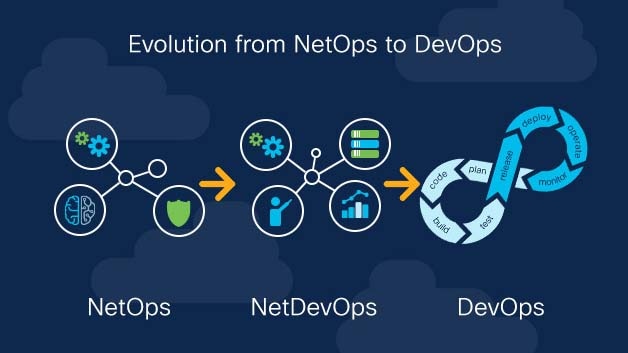Why is a NetOps approach needed?
Today's digital enterprise must be more agile than ever to keep pace with customer expectations. Continuous network automation and validation are designed to simplify network operations to increase speed and efficiency, improve availability, and foster agility and innovation.
However, network troubleshooting still accounts for a significant amount of NetOps engineering time, and needs to be optimized with agile platform strategies.
To support this goal, DevOps has incorporated tools such as automation and orchestration to dramatically reduce response times and development cycles.
Historically, networks have been an obstacle to agile development, managed manually and in a reactive, unplanned way, with an emphasis on availability rather than performance.
With the rise of complex digital enterprises and the need for greater agility and faster content delivery, the network—and network management—must play a bigger role in the development process. NetOps teams need an integrated view of health and performance, as well as insights so they can take action faster.
NetOps brings DevOps concepts like automation, orchestration, and virtualization into network operations, allowing it to be part of the development process. A consistent view across infrastructure and applications data allows NetOps and DevOps teams to share a common view of the data.
How is NetOps deployed in enterprises?
In some cases, NetOps can be adopted through technology. For example, tools originally designed to help automate workflows, such as Ansible, Puppet, and Chef, have been upgraded to include network operations in their process. These tools allow DevOps teams to make configuration changes and update devices automatically.
However, NetOps is not simply deployed through technology. It's a mindset that may require cultural shifts to be fully embraced.
In the past, the missions of development and network teams often clashed, with developers prioritizing robust applications and rapid deployments, while network teams prioritized availability, reliability, and capacity.
How does NetOps relate to DevOps and SecOps?
NetOps, DevOps, and SecOps are all relatively new methodologies in three areas—networking, development, and security—involved in successful agile deployments. Ideally, NetOps, DevOps, and SecOps are interdependent and form parts of a collaborative process.
What is a software-defined network (SDN)?
Software-defined networking (SDN) is an architecture designed to make a network more flexible and easier to manage. SDN centralizes management by abstracting the control plane from the data-forwarding function in the discrete networking devices.
With SDNs, applications and the network are part of a single system, where the network is designed and deployed according to the requirements of applications and an optimized user experience.
An SDN is changeable and adaptive as applications are growing, reconfiguring, and reallocating to reliably deliver the desired business outcomes.
